
By Frank Ricci, Justin McCarthy, Jason Rivera, and P.J. Norwood
What is old is new again. Yes, flow path control is not new, noted texts dating back to the 1800s. What is new is our increased understanding of scientific principles. (Photo 1 by Christine Ricci of firefighter deploying curtain.)
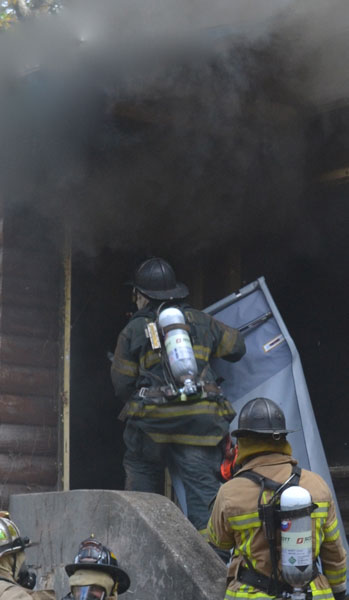
The Old Salts
The fire service always seems to get half of the picture. Think about this: A crew performs the tactic of VEIS or VES, as it is the same tactic. Even before 1992, closing the door was always a part of it. We understood that failure to close the door would draw the fire. If the crew failed to close the door, after finding a victim, the fire drove them back out of the window, making the rescue a recovery. There would not be one old salt at the kitchen table chucking rocks at this breakdown in tactical excellence.
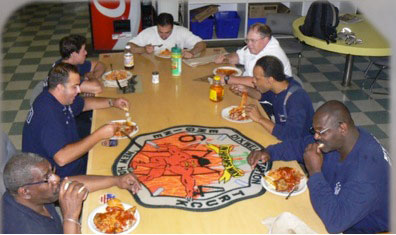
(Photo 2 by Nick Ricci.) Now take the same kitchen table crew of old salts that would enter the front door before the line and not close the door–the same crew who would perform conventional searches, breaking windows without having a line in place.
Are we starting to get the whole picture now? The fire never got the memo of how they entered or if they broke glass from the inside or outside. Entry is ventilation, breaking windows is ventilation. Underwriters Laboratories (UL) and the National Institute of Standards and Technology (NIST) confirmed that ventilation moves fire. It is time we bridge the gap between science and practical application.
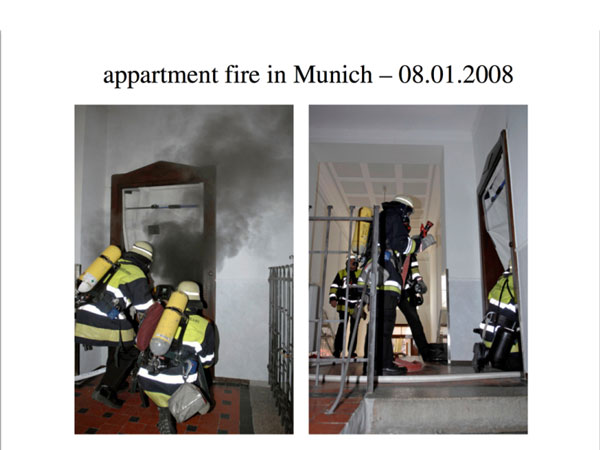
Germany Experience
(Photo 3 provided by Eddie Buchanan.) Dr. Michael Reick, the designer whose body of work has helped place draft curtains in almost every German fire department, attended the FDIC 2014 class “Appling Science Without Abandoning Aggressive Tactics” taught by Frank Ricci. He commented on the success of using curtains to quickly manipulate or control interior flow paths in Europe. He also mentioned that curtains are also used as smoke curtains to keep smoke out of the attack stairwell. I think he was surprised when we stated in jest, “That doesn’t matter; just because it has worked for numerous years and countless fires, we in the United States would have to put it to the test!”
A Typical Example of Smoke Curtain Use
Newtown Experience
The first test came this fall while working in conjunction with Newtown (CT) Hook and Ladder Fire Co #1. Thanks to Chief Raymond A. Corbo for his dedication to firefighter safety and survival.
Firefighters from New York, Connecticut, and Maryland were invited to evaluate performance and tactics while using draft curtains during realistic fire conditions. (Photo 4 Flow Path Definition)

Flow Path
The term flow path has become one of the new buzzwords. Many think of flow path as the path the fire, smoke, and heat travel from the fire to either a failed window or a vent hole cut intentionally through the roof. While this is correct, another piece of the puzzle needs to be discussed.
While high pressure will move to low-pressure areas, it is important to realize that air is being entrained in below the neutral plain. This air equates to energy, intensifying the fire. Proper tactics for curtain deployment are critical to interrupt the air flowing into the fire.
Forcing the Door for Fire Attack
Entry made through a door is ventilation. This open door provides the path of least resistance that the fire is looking for and will draw the fire from its point of origin, down the hallway, and out the front door. This opening will also entrain air, intensifying the fire. This will only complicate our operations. It will slow down entry for both search and attack, as well as spread fire into uninvolved parts of the house where victims may be awaiting rescue.
Present U.S. Tactics
Some departments have chosen to combat this by one of two methods. The first is leaving a firefighter at the door to basically tend and control the door. The other is to partially close the door.
1. Using a Control Firefighter–Los Angeles County (CA) has implemented this plan. The firefighter at the door feeds line and controls the door. He closes the door to slow the flow path and only opens it when a team needs to make entry or exit the building. This method is very effective; however, understanding the operational realities departments face with budget cuts, reduced staffing, and a lack of volunteerism, who has the staffing to dedicate a firefighter to this task? Note we are believers that everyone wants to come to your fire, and it is your responsibility to ensure that enough personnel are on scene to simultaneously combat the fire.
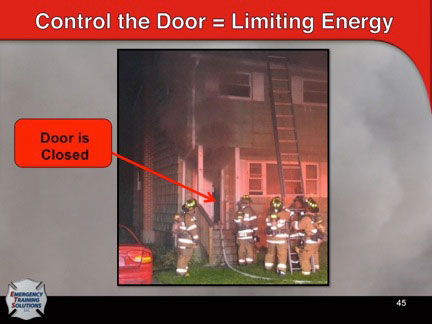
2. Chocking Door Partially Closed–The other method we’ve seen is to chock the door open about a quarter of the way. The door is chocked in both directions to prevent it from opening or closing. In theory, this method cuts down on the size of the opening, which may reduce the speed of the flow path, but leaves some visible light for anyone seeking emergency egress out of the building. The problem we see with this method is the ease in which a firefighter could miss the opening and not be able to escape in an emergency situation. This is a critical problem that could cost a firefighter his life.
Flow paths have been measured up to 15 mph, much faster than any of us can crawl. (Photo 5 provided by the Wallingford Fire Department.)
The life safety of any possible victims is still the number one goal. The quicker we can perform searches, the better the possible outcome for victims. Strategic goals performed with sound tactics must include limiting energy to the fire while ensuring a path of egress for the interior hose teams and search crews.
3. Using the rapid intervention team (RIT) for door control–Many departments have challenges with their staffing levels. For the departments who show up with too few firefighters to position someone at the door, consider using a member of the rapid intervention team (RIT) as the door control firefighter. However, this firefighter who is assigned to RIT cannot deplete any of his air supply for this assignment. Therefore, if the position requires the firefighter to be on air, it is not advisable to use a RIT member.
4. Using a Draft Curtain–We had an opportunity to study deploying draft curtains during several room-and-contents fires. During the first fire, once the fire reached a preflashover stage, noted by visible rollover, fire propagation down from the ceiling, and high heat, Operations ordered the truck crew to force entry. (Photo 6 by Laura Callan; photo 7 by Peter Callan.)
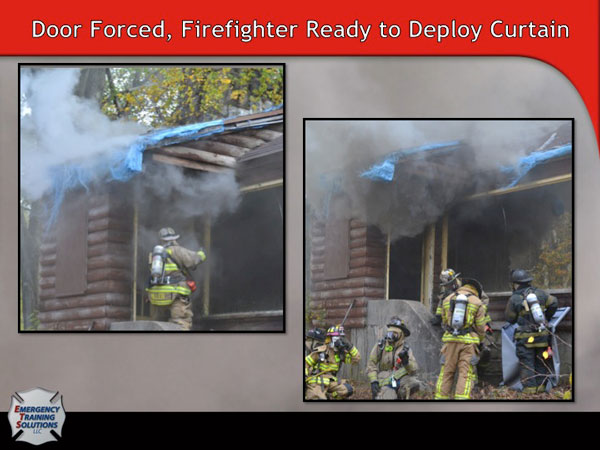
As soon as you force the door, place the curtain. If your company finds the door wide open before you are ready to deploy the curtain or make entry, close the door immediately.

Placing Curtain in Doorway
According to Justin McCarthy: “Being the firefighter who was tasked with placing the curtain during the evolutions, I had my reservations. While the science is there, I can speak for many who work in understaffed and overtasked departments who look at this as an added time constraint when they are already behind the eight ball. It was quickly proven how incorrect my initial speculation was. Time and time again, the curtain went up and stayed up with ease, and within seconds of the door being opened. As a solitary firefighter, I needed nothing other than my two hands and a quick adjustment to lock the curtain in an optimal position. Once set, I was able to quickly advance under the curtain for a primary search with the line coming right behind me. This created a great flow path preventer, limiting air flow to the seat of the fire, granting the search and attack crews the added time they needed to keep the fire to a single room.”
Moving under Curtain
It was reported on the ease of moving under and through the curtain to search and advance the line. When the curtain was deployed, there was a slight elevation in temperature and an apparent slowing of fire growth and flow path, which eased the attack lines entry.
When water was applied to the fire, it was quickly knocked down and then extinguished fully. One thing that we did not think much of till we noticed it during the live burn was how dark the interior stayed after deploying the curtain. There was no back lighting behind the hose team. While this is a minor issue, it is something your members should be aware of. We talked to Tempest about this, and the company is looking into lighting the bottom of the curtain with LED lights. (Photo 8 by Laura Callan.)
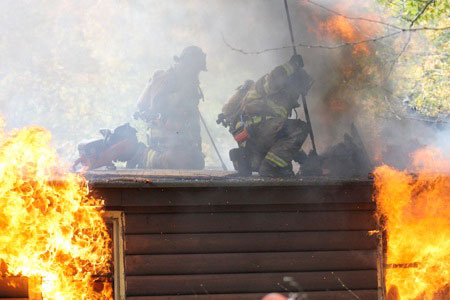
Second-Floor Fire
The second fire the curtain was used on was a second-floor fire in a bedroom. The bedroom was immediately off the top of the stairs, and the attack line was brought in through the front door and up the stairs. The attack line was intentionally staged at the top of the stairs with no water being applied to the fire so the curtain could be deployed several times and changes in conditions noted. The curtain was placed inside the front door in a hallway just prior to the bottom of the stairs leading to the second floor. As the fire began to grow, it was very obvious that opening the front door created a flow path. We could see the neutral plain getting lower, air being entrained on the bottom of the doorway, and heat moving out of the room on the top.
When the curtain was deployed, the flow path would visibly slow down, as would the fire growth, and when the curtain was removed, the flow path and fire growth would increase in speed and intensity. Once these evolutions with the curtain were completed several times, the curtain was left in a deployed position and the attack line entered the room, extinguishing all visible fire in quick order. The curtain appeared to do exactly what it was designed to do: slow the speed of the flow path down.
[bc_video account_id=”1214147015″ player_id=”r17pb6d1Zl” video_id=”3954566300001″ min_width=”405px”]
To summarize our findings of deploying the Tempest Pathmaster Curtain, we found that the curtain does in fact slow the flow path and fire growth in one-room fires at both first- and second-floor fires in single-family dwellings. The curtain deploys with relative ease with a minimal amount of training. In some situations, the curtain could be deployed by a firefighter that may not be SCBA certified if it is placed from the outside of the building in a smoke- free environment much like what could be found at a fire on the second floor. Whatever method a department chooses to control flow path, it must be one that is simple, fast, and readily available; most of all, it must have the safety of the firefighter on the inside in mind.
No one is debating the necessity of controlling the openings at today’s fires. How to best complete this task is what needs to be determined. There is no one-size-fits-all tactic for every department. There are too many variables in all of our departments. The goal of the fireground is to rescue civilians and extinguish the fire the quickest way possible. In doing both, we must also be aware of all inlets and control those by the means that best fits our agencies.
Our goal of containing the fire to the room of origin is more important than ever. Draft curtains may help facilitate this goal by keeping the fire rich until ventilation can be coordinated with the application of water.
- Ventilation Limited Fire: Keeping it Rich and Other Tactics Based Off Science
- Humpday Hangout: Smoke Curtains, Ventilation, and High-Rise Firefighting
- The Job: Flow Path and Door Control
CORRECTION: The original version of this article confused Los Angeles City (LAFD) and Los Angeles County tactics. It has been amended.
Frank Ricci is an advisory board member of Fire Engineering. He is the drillmaster for the New Haven (CT) Fire Department and co-hosts the FE Blog Talk Radio show “Politics & Tactics.” He is a noted author, contributing to several book and DVDs. His series “Tactical Perspectives” is available from Fire Engineering Books.
Jason Rivera has 22 years of fire service experience in both the career and volunteer services. He is a retired captain from Rescue Co. 1 in the Stamford (CT) Fire Department, where he worked for 16 years and currently works as a firefighter for the New Haven (CT) Fire Department assigned to Engine Co. 6. He is also a former chief and current assistant chief for the Newtown (CT) Hook and Ladder Fire Co.
P.J. Norwood is a deputy chief training officer for the East Haven (CT) Fire Department and has served in the CT Army National Guard. He was a key contributor to the “Tactical Perspectives” DVD series. He is an advisory board member of Fire Engineering, an FDIC Instructor, an FE Blog Talk Radio host, and co-creator of Fire Engineering’s video blog “The Job.” He is also a technical panel member for UL’s Study of Residential Attic Fire Mitigation Tactics and Exterior Fire Spread Hazards on Fire Fighter Safety.
Justin McCarthy is a firefighter in the (CT) Fire Department; prior to that he worked with the Westport and Wilton Fire Departments. He works as a fire instructor for the Wolcott Regional Fire School. He has a BS in fire science from the University of New Haven and has co-written the “Tactical Perspective” DVDs with Frank Ricci. He has presented at FDIC and also co-hosts the PJ Norwood show on FE Blog Talk Radio.

